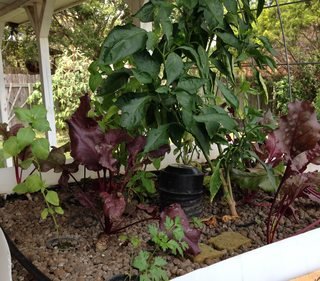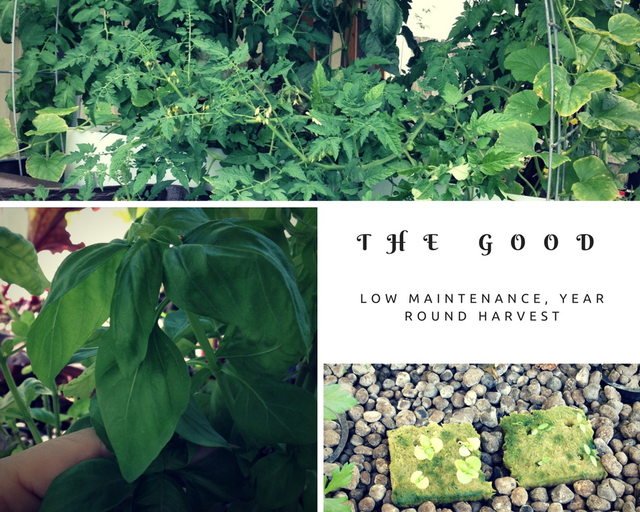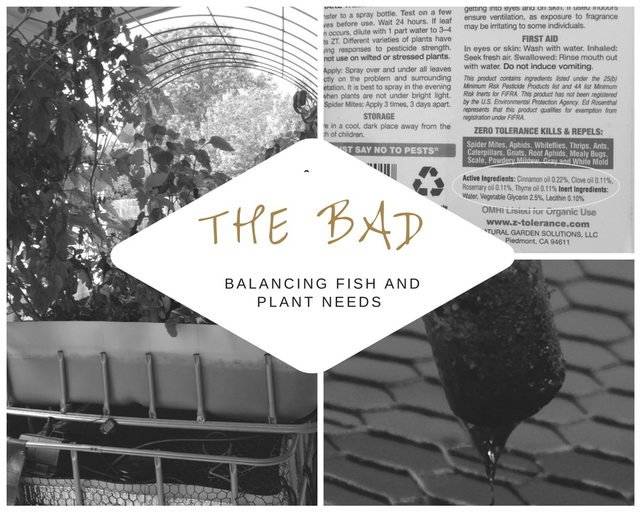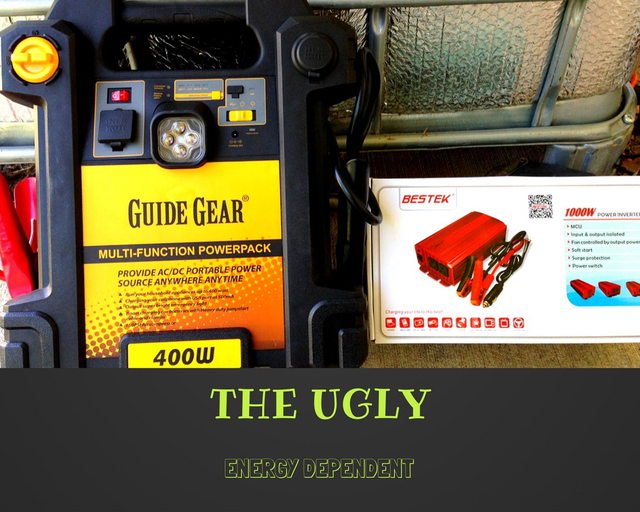
October marks the one-year anniversary of getting my aquaponics system up and running. I thought I’d share my experience with anyone thinking of going the aquaponics route for food production.
I’m using a 275-gallon Intermediate Bulk Container (IBC) for the tank and grow bed with a flood and drain method that I modified myself. Now, there are various sizes and designs for an aquaponics system using equipment specifically manufactured for this purpose, but by building it myself (and making many mistakes) I learned more about how the system functions and find troubleshooting problems fairly easy.
Here’s my experience with aquaponics:

Low maintenance. Once setup, fully cycled, planted, stocked with fish, and the flood and drain pump is on timer there is very little else to do except feed fish (auto feeder in use) and test the water weekly. And of course, harvest.
Great for seed starting, especially more difficult seeds like parsley, which need to be kept moist until germination. Just drop seed into starter plug and wait for the sprout.
Can grow heat loving veggies and herbs like basil through winter. My system is outside (in Hardiness Zone 8) and I have fresh basil through winter due to the heated water from the fish tank keeping the grow bed warm.
You get a lot of food in a small space. I am reorganizing my system to focus primarily on herbs and cut-and-come again greens like Swiss Chard. I’ve had the most success with these and they provide an ongoing harvest without need for replanting.

Getting the fish/plant balance can be tricky. The plants need sufficient fish waste for nutrients and the fish need enough plant roots filtering waste out of the water. If the nitrate levels are too low, remove and eat plants and/or add fish. If too high, add plants (if space available) and/or remove and eat fish.
Plants that are heavy feeders, like tomatoes, will require additional mineral supplements. The quality of fish food will also be a factor. A local supplier where I live sells food formulated for aquaponics tilapia.
Sudden fluctuations in pH, temperature or ammonia and nitrite levels can be stressful or even fatal to the fish. I sent several channel catfish to an early grave due to improper pH and ammonia management. (I’m so so sorry!)
Plants will still be vulnerable to pests, but any treatment will need to take into account effects on the fish. Even some pest control products labeled ‘organic’ may not be healthy to the fish. Seek out a local vendor specializing in aquaponics to guide you through the process.
As roots grow, they have a tendency to interfere with water draining from the grow bed. A clogged drain can cause an overflow and drown the plants. Keep drains clear, have an emergency overflow drain and grow shallow root plants to avoid this problem.

- POWER! This is the only point I have experience with that is (or can become) truly ugly. The water pump, heater and air pump are all dependent on energy to run. If the power goes out, the water stops circulating through the grow bed.
This 1) stops the ammonia -> nitrate cycle and fish waste begins to accumulate in the tank. 2) stops water oxygenation and if the outage lasts long enough, the fish will suffocate and 3) will cause plant roots to dry out and the plants die.
An extended power outage could wreck the system. This almost happened to me last spring when a severe storm knocked out power for over 12 hours. Luckily, I had a 400watt multi-function power pack I keep in the car for a jump or flat/low tire and was able to plug in the water and air pumps until the power came back. The outside temperature was warm enough, so the heater wasn't necessary. The power pack would not have been able to handle the load anyway. I’ve since purchased a 1000watt inverter that I can hook up to the battery of an idling automobile. (Thanks to Steven Harris at battery1234.com for the idea!)
All in all, I feel an aquaponics setup is a good asset to have in a food security arsenal. It’s ideal for small spaces where garden beds, greenhouses or chicken coops would not be possible. It also works great for areas that do not get much rainfall or not enough at the right time of year.
For me, it’s one more source of clean, NON-GMO food that I have no concern eating or feeding my family.
Happy AquaPioneering!
Have you tried solar power?
Downvoting a post can decrease pending rewards and make it less visible. Common reasons:
Submit
This post has been linked to from another place on Steem.
Learn more about linkback bot v0.4. Upvote if you want the bot to continue posting linkbacks for your posts. Flag if otherwise.
Built by @ontofractal
Downvoting a post can decrease pending rewards and make it less visible. Common reasons:
Submit
This is a fantastic post. I particularly appreciate the trouble-shooting advice. I've been interested in aquaponics. Thanks for sharing some of what you have learned. :)
Downvoting a post can decrease pending rewards and make it less visible. Common reasons:
Submit
You're welcome. And thank you for the compliment. I'm glad you liked it. Aquaponics can seem like a complicated science experiment, but once you get going it's not much more difficult than having a fish tank.
Downvoting a post can decrease pending rewards and make it less visible. Common reasons:
Submit
How many sq/ft do you think you are growing plant material in?
What do you think your approximate investment is, in your particular set-up?
Downvoting a post can decrease pending rewards and make it less visible. Common reasons:
Submit
The grow bed area is approx 11 sqft and a foot deep. The IBC tote was US$125 and the grow media around $100 (I’m using expanded clay, which is on the pricier end). The pump, water heater and tubing were each around $20. So all in, it was just under $300. The area is facing southeast, so the sun is providing light from spring-fall. I use a small UFO LED light w/ blue and red spectrum to boost growth in the winter. I think this was around $80. With the size of the holding tank, I could add more fish and another grow bed, but right now I’m keeping the size manageable. Hope this helps.
Downvoting a post can decrease pending rewards and make it less visible. Common reasons:
Submit
Yes it does thank you. I think you've still come in around $400. Relatively inexpensive production costs for nutritionally dense food...year round I might add!
Well done!
Downvoting a post can decrease pending rewards and make it less visible. Common reasons:
Submit
I haven’t been measuring the output, but I get a big bunch of basil every 2 weeks just from the 3 basil plants. This would cost $2 at the grocery store…about $50/year. I’ve grown tomatoes, peppers and even 1 small melon over the summer (total grow bed overload – nitrate level dropped to zero). I’m shifting the focus to herbs (basil, parsley, cilantro and chives) because I think those would provide the best return per sqft. Swiss chard and radishes will probably make an appearance as well.
Downvoting a post can decrease pending rewards and make it less visible. Common reasons:
Submit
I would love to learn more about aquaponics : )
followed ; )
Downvoting a post can decrease pending rewards and make it less visible. Common reasons:
Submit
Thanks! Backyardaquaponics is a good starting point. I did some of my research there when I was starting out.
Downvoting a post can decrease pending rewards and make it less visible. Common reasons:
Submit
I wonder if an aquaponics system could be designed to go on a small houseboat? It's been done on a barge
Downvoting a post can decrease pending rewards and make it less visible. Common reasons:
Submit
If you can put an aquarium in it, then I think aquaponics would also work. I've seen small fish tanks no more than 10 gallons with a small grow bed and light over top.
Downvoting a post can decrease pending rewards and make it less visible. Common reasons:
Submit
I've been thinking.
Fish live in river/lake water already.
Is that water SO bad that it couldn't be used for an 'aquaponic' system?
I'm wondering how such a system, using river/lake water, could be integrated into a small houseboat (very small, like tiny house small).
Would something like 'reverse osmosis' be needed? Would it work?
Assume you're building a SHTF bug out boat, and plan to live off shore to avoid problems. How would it be designed?
I'm sure Ocean water (salt) would involve a whole nuther set of problems...
Downvoting a post can decrease pending rewards and make it less visible. Common reasons:
Submit
I use RO to filter all water going into the AP system, but you can use rainwater if you have a Collection System. I've never heard of saltwater AP. I know you wouldn't be able to grow the usual veg and herbs as the salt would kill the plants. Do you like seaweed?
Downvoting a post can decrease pending rewards and make it less visible. Common reasons:
Submit
Seaweed isnt' bad, with enough hot sauce. I've had it with Sushi.
Downvoting a post can decrease pending rewards and make it less visible. Common reasons:
Submit
I would think that all things on the leafy side would do well. If you can grow radishes ok, they can be a very versatile food. I use them in soups and I fry them like potatoes. With cooking, they lose a lot of their heat. A good crop to master if we ever have to produce all of our own food. :)
Downvoting a post can decrease pending rewards and make it less visible. Common reasons:
Submit
Yes. Radishes are quick to mature, compact and both root and greens are edible. I use the greens as a basil substitute in pesto recipes and just yesterday sauteed some daikon radish greens (from garden bed not AP) in butter and garlic - taste is similar to broccoli rabe.
Downvoting a post can decrease pending rewards and make it less visible. Common reasons:
Submit
You give me matter to think about. We are growing our vegetable during the summer but had no plans so far for the winter. I actually had never thought about an aquaponic system. I am however afraid of the installation that could get tricky (which you seem to confirm). Thanks for this very objective post in any case.
Downvoting a post can decrease pending rewards and make it less visible. Common reasons:
Submit
Thanks! I hope I didn't scare you away from aquaponics. Once up and running, it's really not much trouble.
Downvoting a post can decrease pending rewards and make it less visible. Common reasons:
Submit
Not at all. What I really need is the time to invest to get started, which I don't have at the moment :p
Downvoting a post can decrease pending rewards and make it less visible. Common reasons:
Submit
I killed my avocado plant when I put some aquaponic liquid bought from the store. I know it is hard to raise plants by aquaponic method.
Up voted and your upvote will be appreciated.
Downvoting a post can decrease pending rewards and make it less visible. Common reasons:
Submit
@autonomygarden funny, my hubby was talking about doing this and we thought of having an extended glass house extension on the 2nd floor and I told him, it could get damp and I bump into this post. I was worried that there'd be greening on the glass house. I bookmarked it for future reference - it's better to take advice from an author who did it himself. Thank you.
Downvoting a post can decrease pending rewards and make it less visible. Common reasons:
Submit
Sounds like a good idea. As long as the glass house is south facing (assuming you are in the northern hemisphere) you may not need artificial light or water heater, which are the energy hogs. The water pump only uses 10Kw/month. Humidity in the glass house may be a bit higher with the AP system, but I couldn't say for sure.
Downvoting a post can decrease pending rewards and make it less visible. Common reasons:
Submit
I've done this for years. Good times!
Downvoting a post can decrease pending rewards and make it less visible. Common reasons:
Submit
I enjoy it. And my son loves feeding the fish!
Downvoting a post can decrease pending rewards and make it less visible. Common reasons:
Submit
Love this post! I'm going to visit a commercial cold-water aquaponics farm up in BC next week and I can't get enough of this stuff. We have a few acres and an empty greenhouse. I'm mulling over investing in a small commercial system while I fiddle with and learn on a small 10 gallon system in my kitchen.
Downvoting a post can decrease pending rewards and make it less visible. Common reasons:
Submit
Very good post!
Downvoting a post can decrease pending rewards and make it less visible. Common reasons:
Submit
Thank you!
Downvoting a post can decrease pending rewards and make it less visible. Common reasons:
Submit
I got some experience too.. Gold 🐠 is very robust, few fish are very PH sensitive. Be careful of bugs and mosquitoe breeding.
Downvoting a post can decrease pending rewards and make it less visible. Common reasons:
Submit
Awesome blog! More pics of your set up would be appreciated and maybe an update since this writing? What kind of fish have you found to be the best for you? You mention tilapia and catfish. Have you settled on one versus the other? Thank you.
Downvoting a post can decrease pending rewards and make it less visible. Common reasons:
Submit